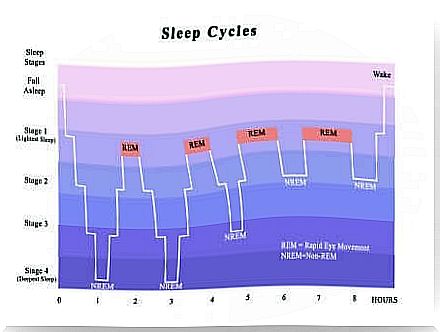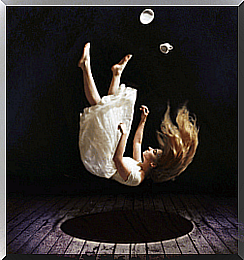What Are The Phases Of Sleep?
Strange as it sounds, science still has a lot of questions about the true nature and function of sleep. We do know, however, that when we sleep a series of changes take place that lead to different phases of sleep.

Sleep phases are times when changes occur while we are asleep. Many people think that when we sleep we are immersed in lethargy-like inactivity. However, it is not the case. During sleep, different processes take place and configure each of its stages.
The presence of the different phases of sleep can be demonstrated through medical tests such as the electroencephalogram, the electromyogram and the electro-oculogram. Through these, we can observe the changes in the electrical conductivity of the skin, the respiratory rate and the heart rate, at each phase.
Some people, when they sleep, do not go through all the stages of sleep and therefore wake up feeling tired and drowsy during the day. This gives rise to various problems. Completing sleep cycles is fundamental to maintaining people’s mental and physical balance.
General aspects of the phases of sleep

Sleep is a process that does not develop linearly but cyclically. In other words, several phases of sleep follow one another sequentially. The latter begins with a state of almost falling asleep, until reaching the deepest sleep. It then returns to the starting point and the cycle repeats.
Each complete sleep cycle lasts between 90 and 100 minutes in the majority of people. Usually, we have between four and six cycles during a normal period of rest overnight. The order in which these different phases of sleep occur is always the same.
In principle, sleep is divided into two main stages. The first is called the slow sleep phase, or non-REM phase; the second is the rapid sleep phase, or REM phase. The acronym REM refers to Rapid Eye Movements .
The phases of slow sleep
The name of slow sleep is given to the non-REM phase because it corresponds to the stage where the brain exhibits slow waves. It represents the stage of transition between the state of wakefulness and that of sleep. We see here dominating a state of light sleep, with reduced breathing.
During this stage, we are not really asleep but rather immersed in a state of dreaming. We still hear the sounds of the environment around us and are only partially disconnected from what is happening around us.
This phase lasts, in total, about 15 minutes, from the moment we close our eyes. However, we only get about five minutes of actual sleep.
Slow sleep, or non-REM phase, is divided into four sleep phases, each with its own characteristics. These phases are:
- Phase I or falling asleep. It lasts about 10 minutes. Muscle tone decreases and eye movements become slow. In some cases, at the beginning and at the end of this phase, one can have hallucinations. It corresponds to 5% of total sleep.
- Phase II or light sleep. The mechanisms to prevent waking up are activated. Heart rate and respiratory rate decrease. The eye movements disappear and sleep begins to be restorative, even if it is not yet completely. This stage corresponds to approximately 50% of sleep.
- Phase III or transition to deep sleep. It is the shortest of all the phases of sleep because it lasts between two and three minutes. The sensory blockage strengthens and sleep becomes deeper. If we wake up, we feel great confusion. At this stage, there are no dreams.
- Phase IV or delta sleep. It is a stage that lasts about 20 minutes and it is rare for a person to wake up at this time. There are no dreams but restorative rest, which is fundamental for body and mind.
The REM phase

The second of the two major phases of sleep is the so-called REM phase, or rapid eye movement. During this stage, the brain is quite active, but at the same time all the motor neurons get blocked and therefore we cannot move.
This phase is also known as “paradoxical sleep” precisely because it presents this contrast between total relaxation of the muscles, typical of rest, and a significant activation of the brain, which is typical of the waking state.
It is also the stage during which we dream and where the dreamlike images are perceived as real. If someone wakes up during this phase, they will clearly remember what they were dreaming about; at least that’s what happens in 80% of people. If a person could move during this stage, maybe they would make their dream come true with deeds.
The REM phase occurs several times during sleep and has a variable duration. The first time it comes, it lasts about 10 minutes, and the last time, between 30 and 40 minutes (for eight hours of sleep). It begins with rapid, irregular breathing and then moves into a state of deep sleep.









